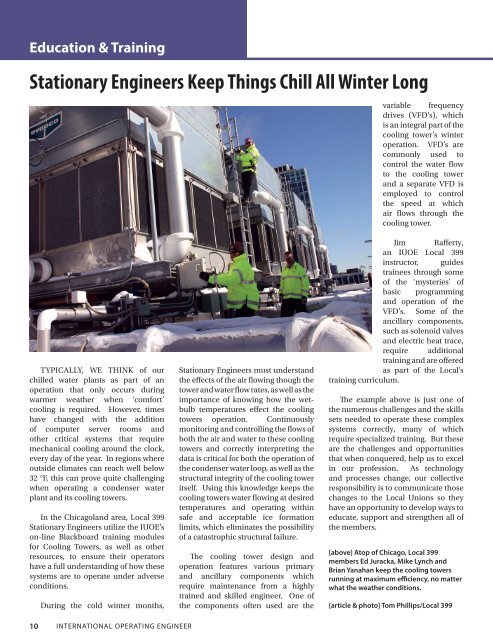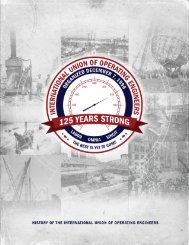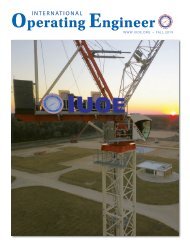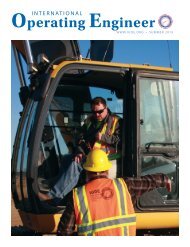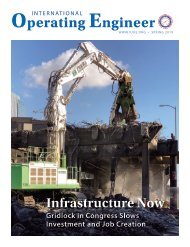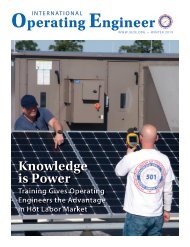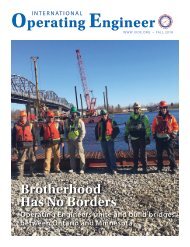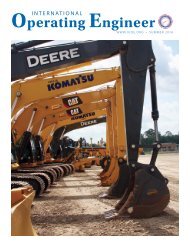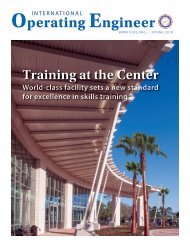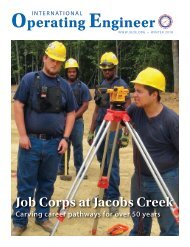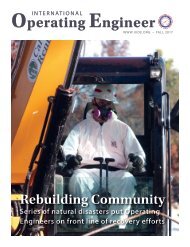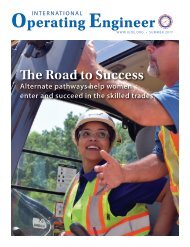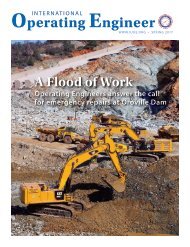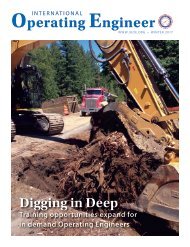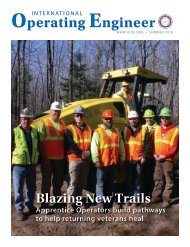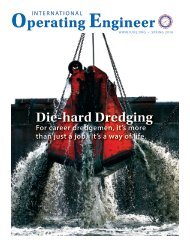Operating Engineer - Winter 2015
The quarterly magazine of the International Union of Operating Engineers.
The quarterly magazine of the International Union of Operating Engineers.
Create successful ePaper yourself
Turn your PDF publications into a flip-book with our unique Google optimized e-Paper software.
Education & Training<br />
Stationary <strong>Engineer</strong>s Keep Things Chill All <strong>Winter</strong> Long<br />
variable frequency<br />
drives (VFD’s), which<br />
is an integral part of the<br />
cooling tower’s winter<br />
operation. VFD’s are<br />
commonly used to<br />
control the water flow<br />
to the cooling tower<br />
and a separate VFD is<br />
employed to control<br />
the speed at which<br />
air flows through the<br />
cooling tower.<br />
TYPICALLY, WE THINK of our<br />
chilled water plants as part of an<br />
operation that only occurs during<br />
warmer weather when ‘comfort’<br />
cooling is required. However, times<br />
have changed with the addition<br />
of computer server rooms and<br />
other critical systems that require<br />
mechanical cooling around the clock,<br />
every day of the year. In regions where<br />
outside climates can reach well below<br />
32 °F, this can prove quite challenging<br />
when operating a condenser water<br />
plant and its cooling towers.<br />
In the Chicagoland area, Local 399<br />
Stationary <strong>Engineer</strong>s utilize the IUOE’s<br />
on-line Blackboard training modules<br />
for Cooling Towers, as well as other<br />
resources, to ensure their operators<br />
have a full understanding of how these<br />
systems are to operate under adverse<br />
conditions.<br />
During the cold winter months,<br />
Stationary <strong>Engineer</strong>s must understand<br />
the effects of the air flowing though the<br />
tower and water flow rates, as well as the<br />
importance of knowing how the wetbulb<br />
temperatures effect the cooling<br />
towers operation. Continuously<br />
monitoring and controlling the flows of<br />
both the air and water to these cooling<br />
towers and correctly interpreting the<br />
data is critical for both the operation of<br />
the condenser water loop, as well as the<br />
structural integrity of the cooling tower<br />
itself. Using this knowledge keeps the<br />
cooling towers water flowing at desired<br />
temperatures and operating within<br />
safe and acceptable ice formation<br />
limits, which eliminates the possibility<br />
of a catastrophic structural failure.<br />
The cooling tower design and<br />
operation features various primary<br />
and ancillary components which<br />
require maintenance from a highly<br />
trained and skilled engineer. One of<br />
the components often used are the<br />
Jim Rafferty,<br />
an IUOE Local 399<br />
instructor, guides<br />
trainees through some<br />
of the ‘mysteries’ of<br />
basic programming<br />
and operation of the<br />
VFD’s. Some of the<br />
ancillary components,<br />
such as solenoid valves<br />
and electric heat trace,<br />
require additional<br />
training and are offered<br />
as part of the Local’s<br />
training curriculum.<br />
The example above is just one of<br />
the numerous challenges and the skills<br />
sets needed to operate these complex<br />
systems correctly, many of which<br />
require specialized training. But these<br />
are the challenges and opportunities<br />
that when conquered, help us to excel<br />
in our profession. As technology<br />
and processes change, our collective<br />
responsibility is to communicate those<br />
changes to the Local Unions so they<br />
have an opportunity to develop ways to<br />
educate, support and strengthen all of<br />
the members.<br />
[above] Atop of Chicago, Local 399<br />
members Ed Juracka, Mike Lynch and<br />
Brian Yanahan keep the cooling towers<br />
running at maximum efficiency, no matter<br />
what the weather conditions.<br />
[article & photo] Tom Phillips/Local 399<br />
10<br />
INTERNATIONAL OPERATING ENGINEER


